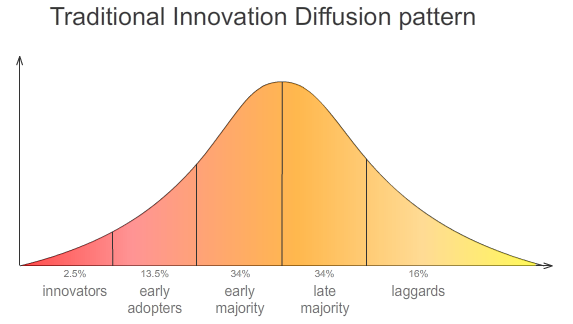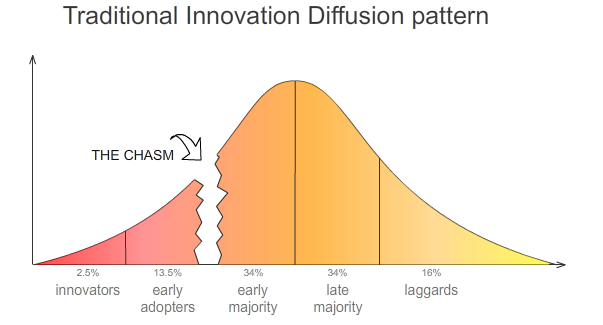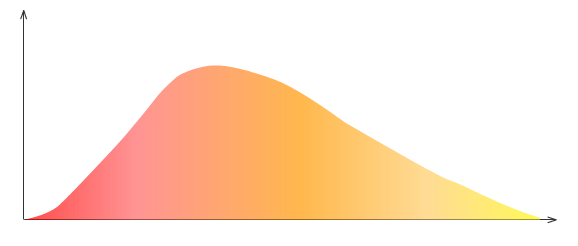The key to successful innovation
We live in a fast moving world where innovations make the difference. But how to make sure your innovation meets the success it deserves?
You might have created a great product that solves problems that no-one could have solved before you. You have a real innovation and are getting ready to market it. But are you sure to know how to market a product that no-one knows?
What is innovation?
In order for our discussion to be clear, let's first define what we consider as innovation. We will consider as innovation any product (service or concept) that isn't an adaptation of an existing item and that isn't known by the large public. Usually, an innovation would either solve a problem that nothing was solving before or bring a new type of value or comfort to its user.

What is the innovation's challenge?
Having an innovative product is exciting. You have created something new, you brought something to the world that no one had created before.
Theoretically, innovations are easy-to-sell products: novelty is exciting and solves problems that couldn't be solved before.
In the facts, innovations can be very difficult to market.
First of all, you might respond to a problem or to a need that people are not aware of. For example, when doctor Levi Spear Parmly invented dental floss in 1815, the innovation was great! He found a perfect way to remove the dirt remaining between the teeth that no brush could reach. His product was responding to a real problem. Unfortunately, even though the problem was real, people were unaware of it. Therefore, this great innovation that sounds like an obvious solution nowadays hasn't been on the market before 1882, 67 years later. Sometimes innovation solves problems that people are unaware of.
Then, unlike most products, innovations are not suitable for everyone. The market reaction to innovations is very specific.
How to successfully market innovations?
There are three main aspects that you must consider seriously before launching your innovation.
As we mentioned earlier, innovations often solve problems that people are unaware of. Your first step is to make sure people understand the problem - you must create the need, or at least let people realize that they need your product.
This can be realized through communication campaigns and partnerships - make people aware of the problem before introducing your solution.
The second aspect to pay attention to is the product explanation. Innovations are new concepts. Therefore, consumers might not understand their purpose or the way to use them. Your communication - and especially your packaging - must be clear and give sufficient information for consumers to understand both the purpose and the method of your product. Would you buy a product without understanding what it does and how to use it?
The last point is also vital: you must carefully define your market. This rule is true for all products but even more essential for innovations. For existing products and adaptation, the market is known. For innovations, the market is new and without a clear definition and segmentation, your innovation will surely fail reaching its target.
In the next paragraph we will see specificities of the innovations market but before that I encourage you to read my article "Target your customers precisely with Buyer Personas" that shall give you guidelines and tools to define your market as efficiently as possible.

The specificities of innovation market
The concept of innovation diffusion was first introduced by the French sociologist Gabriel Tarde in 1890.
According to the traditional innovation diffusion pattern, people can be divided in 5 groups:
- innovators
- early adopters
- early majority
- late majority
- laggards
The innovators represent a very small portion of the population (≈2.5%). True innovators are people who are willing to take risks and spend money to be the very first using innovating items. Socially, innovators are usually young, social and have financial ease. If you read my article "The Art of starting an epidemic", you know that innovators are also usually Mavens: they are specialists in their fields and always aware of innovations before anyone else.
The early adopters represent 13.5% of the population. In this group, people are also young and have financial lucidity. They are usually Connectors and are very social. Always having the latest popular innovation is a must for early adopters in order to keep and confirm their special status. Those people create trends.
The early majority is made of simple followers. Once the early adopters have set the trend and define an innovation as a required item, the early majority starts using it. The elapsed time between the early adopters and the early majority usage is rather long. The early majority will not use the product before it becomes trendy and popular.
The late majority is a very skeptical group. People in this group do not like innovations much and would only start using those items once most people are using them already.
The laggards represent the last category of population. Laggards are usually older people with aversion toward innovation. They will adopt innovations only when they have no other choice and prefer using what they know already.
Now you have a better view of who you must convince and how to approach those people. This is important as you must know your market before launching your product.
The Innovation chasm
The chasm is what separates the "easy portion" of the population from the rest. Most innovative products manage to reach the first 15% of the population (innovators + early adopters) and fails crossing the chasm separating them from the rest of the population.
Crossing the chasm is a real challenge but also a necessary step to be successful. Once your product went over this gap, spreading it should be much easier. However, many innovative products failed crossing this fence resulting into a global failure of the innovation. You must absolutely consider this element when building your market strategy.
The new trend of innovation diffusion
As mentioned earlier, the innovation diffusion pattern was first introduced in 1890.
However, the pace of innovation development has exploded in the past 60 years, changing the rules.
Since Second World War, the development of industry, cars, electronics and communication grew exponentially. There have been more innovations in the past 60 years than in the previous 200 years.
The development of internet has been a major breakout in consumer's behavior and in the innovation adoption pattern.
The example of Apple clearly shows this change of mentality. All new products developed by Apple that could be considered as innovations (iPhone, iPad, etc.) crossed the chasm in no time.
Over the years, the repartition of population on the innovation diffusion chart has changed and moved to the left.
Even though the traditional concept is still true, the way we consider the market and the repartition of each group must be carefully considered.
How to launch my product
There is no golden rule on how to successfully market an innovative product. However, some basic principles apply and can help you choosing the right direction when launching your product.
Study your market: do not jump directly without considering who your potential customers are and how to reach them.
Test the product: this aspect concerns all products but makes even more sense with innovations. Test your product with focus tests before launching it. You must be able to predict consumers' behavior toward your innovation before launching it. It might also be a good way to modify or improve your product based on consumers' feedback before starting production.
Make sure all is clear: to you the product is clear and straight forward. But is it really the case? Keep in mind that consumers never tried your product before and might not even have considered needing such item. Your communication in general and your packaging in particular must clearly state what the item's purpose is and how to use it.
Simplify everything: if an item requires reading a complete instructions manual to use it, then the item isn't convenient. The success of iPhone compared to similar products can also be explained with this principle. If your product is straight forward and has a very simple interface or usage, you increase the chances people would use it.
Considering all those points should give you a better overview of the challenge that represents launching an innovation. It might seem like a hassle to work with innovative products; however, innovators are always ahead of others and show more success than followers in the long term.
If you want to read more about innovation from a master of "being unique", I strongly encourage you to read the excellent "purple cow" from Seth Godin that is really a business changer.
Last update: 2024-04-16 Tags: innovation marketing bring to market product launch innovation diffusion


















 Français
Français English
English